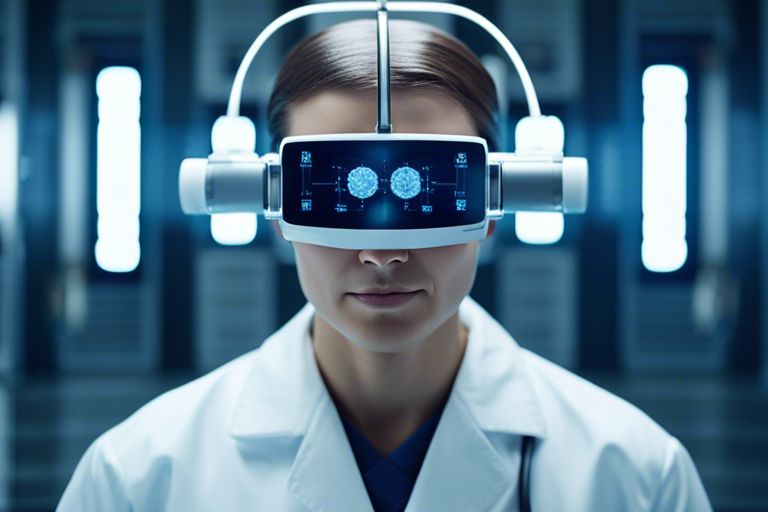Through the lens of modern innovation, you are launching on a journey into Transcranial Magnetic Stimulation (TMS) technologies. In this blog post, you will investigate into the fascinating world of cutting-edge advancements that are revolutionizing the field of neurostimulation. Begin your exploration now and uncover the incredible potential these TMS technologies hold for shaping the future of scientific research and medical treatments.
Key Takeaways:
- Automation: TMS technologies offer cutting-edge automation features that streamline transportation management processes.
- Visibility: Real-time visibility into supply chain operations allows for informed decision-making and improved efficiency.
- Integration: Integration with other systems and technologies such as IoT and AI enables seamless data exchange and enhances overall logistics operations.
Principles of TMS
History of TMS Development
A fascinating history lies behind the development of Transcranial Magnetic Stimulation (TMS). On your journey to understanding this cutting-edge technology, it’s crucial to appreciate the roots from which it sprouted. TMS emerged in the mid-1980s, pioneered by Anthony Barker and his team at the University of Sheffield. Their initial goal was to develop a non-invasive technique to stimulate the brain in a way that could help diagnose and treat neurological disorders.
How TMS Works
The fundamental principle behind how TMS works revolves around the generation of magnetic fields to induce electrical currents in specific regions of the brain. The coil of the TMS device is placed on the scalp, delivering focused magnetic pulses that stimulate the underlying neural tissue. These pulses can modulate brain activity, offering insights into brain function and potential therapeutic applications. The ability to target precise brain regions with TMS has revolutionized the field of neuroscience and opened new avenues for treating conditions such as depression, chronic pain, and more.
The magnetic pulses generated by TMS devices are crucial in influencing neuronal activity in the brain. As the magnetic field penetrates the scalp and skull, it induces electrical currents that depolarize neurons in the targeted area. This process can lead to the activation or inhibition of specific neural circuits, offering researchers and clinicians a powerful tool to study brain-behavior relationships and develop innovative treatments for various neurological and psychiatric conditions.
With its ability to non-invasively modulate brain activity, TMS has become a valuable tool in both research and clinical settings. Whether you are exploring the mysteries of the brain or seeking innovative therapies for neurological disorders, understanding the principles of TMS is imperative for unlocking its full potential in advancing neuroscience and healthcare.
Advances in TMS Technology
The field of Transcranial Magnetic Stimulation (TMS) is constantly evolving, with new technologies pushing the boundaries of what was once thought possible. In this chapter, we will explore some of the cutting-edge advancements in TMS technology that are revolutionizing the field.
Coil Design Innovations
For TMS to be effective, the design of the stimulation coil is crucial. Recent innovations in coil design have led to more focused and precise targeting of specific brain regions. By optimizing the shape, size, and orientation of the coil, researchers have been able to enhance the accuracy and efficacy of TMS treatments.
Pulse Width and Frequency Optimization
Designing TMS pulses with the right width and frequency is crucial for achieving the desired therapeutic outcomes. By fine-tuning these parameters, researchers can customize TMS treatments to target different neural pathways and brain functions. The ability to optimize pulse width and frequency opens up exciting possibilities for personalized TMS therapy.
Plus, recent studies have shown that pulse width and frequency can significantly impact the magnitude and duration of TMS effects. Researchers are now exploring how variations in these parameters can lead to more sustained and potent neuromodulatory effects, paving the way for enhanced TMS protocols.
Multi-Coil Systems
Any discussions about cutting-edge TMS technologies would be incomplete without mentioning the development of multi-coil systems. These innovative setups consist of multiple coils working in synergy to deliver targeted stimulation to complex brain networks. By combining the advantages of different coil configurations, multi-coil systems offer unprecedented flexibility and precision in TMS applications.
Advances in multi-coil systems have opened up new possibilities for studying brain connectivity and network dynamics. Researchers are now able to investigate how different brain regions interact and modulate each other, leading to a deeper understanding of brain function and dysfunction. By leveraging the capabilities of multi-coil systems, the field of TMS is moving towards more sophisticated and impactful research and clinical applications.
Applications of Cutting-Edge TMS
Neurological Disorder Treatment
For neurological disorder treatment, cutting-edge TMS technologies have shown remarkable promise in conditions such as depression, anxiety, and even post-traumatic stress disorder (PTSD). By precisely stimulating targeted areas of the brain non-invasively, TMS can help regulate mood and alleviate symptoms in individuals who have not found relief through traditional methods.
Pain Management and Relief
For pain management and relief, TMS technologies offer a non-pharmacological approach that can be effective for individuals dealing with chronic pain conditions. By modulating the neuronal activity in pain-processing regions of the brain, TMS can reduce pain perception and provide relief without the side effects associated with medications.
TMS has been particularly beneficial for patients with fibromyalgia, migraine headaches, and neuropathic pain. Unlike traditional pain management techniques, TMS targets the brain directly, offering a novel way to address chronic pain at its source.
Cognitive Enhancement
For cognitive enhancement, cutting-edge TMS technologies have opened up new possibilities in improving memory, attention, and executive functions. By stimulating specific brain regions involved in cognitive processes, TMS can enhance neural connectivity and optimize brain function.
Management of conditions such as Alzheimer’s disease, attention deficit hyperactivity disorder (ADHD), and age-related cognitive decline may benefit from TMS interventions. The non-invasive nature of TMS makes it a promising avenue for boosting cognitive abilities without the need for invasive procedures.
Safety and Efficacy Considerations
Adverse Effects and Contraindications
The safety of any advanced Transcranial Magnetic Stimulation (TMS) technology is paramount. After reading about Our Cutting-Edge Technology: TMS, CFS, and Delivery Management, you may be wondering about adverse effects and contraindications. The welfare of patients undergoing TMS therapy should always be the top priority.
Clinical Trial Results and Findings
One crucial aspect of evaluating cutting-edge TMS technologies is through clinical trial results and findings. The insights gained from these trials can provide valuable information about the efficacy and safety of the technology. Researchers meticulously analyze data to draw meaningful conclusions that can shape the future of TMS treatments. These findings contribute to the ongoing refinement and development of TMS technologies.
Efficacy.
Regulatory Frameworks and Guidelines
Results.
Emerging Trends in TMS Research
Personalized TMS Protocols
Research into personalized transcranial magnetic stimulation (TMS) protocols is at the forefront of innovation in the field. By tailoring TMS treatments to individual patients based on their specific neural profiles, researchers aim to enhance the precision and efficacy of this non-invasive brain stimulation technique. Your treatment plan could soon involve a personalized TMS protocol designed to target the exact brain regions implicated in your condition, leading to more effective outcomes and reduced side effects.
Combination Therapies and Integrative Approaches
One exciting trend in TMS research involves exploring the potential benefits of combining TMS with other therapeutic modalities, such as cognitive-behavioral therapy (CBT) or pharmacological interventions. By integrating TMS into a comprehensive treatment plan, researchers aim to enhance the therapeutic effects and long-term outcomes for individuals with various neurological and psychiatric disorders. Your healthcare provider may recommend a combination therapy approach that includes TMS as part of a multi-faceted treatment strategy tailored to your specific needs.
With ongoing advancements in TMS technology and treatment protocols, the integration of complementary therapies alongside TMS holds promise for optimizing patient care and improving treatment outcomes.
Advanced Neuroimaging Techniques
- Neuroimaging Techniques:
1. Functional Magnetic Resonance Imaging (fMRI) 2. Diffusion Tensor Imaging (DTI) 3. Positron Emission Tomography (PET) 4. Magnetoencephalography (MEG)
Advanced neuroimaging techniques play a crucial role in TMS research by providing insights into the underlying neural mechanisms of TMS effects on the brain. Researchers utilize techniques such as functional magnetic resonance imaging (fMRI) and diffusion tensor imaging (DTI) to monitor changes in brain activity and connectivity following TMS interventions. By combining TMS with cutting-edge neuroimaging modalities, researchers can enhance their understanding of how TMS modulates neural circuits and influences brain function.
- Trends:
1. Integration of neuroimaging with TMS studies 2. Development of real-time neuroimaging-guided TMS 3. Application of neuroimaging to personalize TMS treatments 4. Investigation of neural plasticity mechanisms using neuroimaging

Commercialization and Industry Outlook
Market Analysis and Growth Projections
Analysis of the transportation management system (TMS) market reveals a promising future for the industry. With the rapid advancements in technology, the global TMS market is expected to experience substantial growth in the coming years. Market projections indicate a steady increase in demand for TMS solutions across various industries, driven by the need for efficient logistics and supply chain management.
Startups and Established Players
Any exploration of the TMS industry will unveil a dynamic landscape populated by both startups and established players. Startups are disrupting the market with innovative technologies and agile solutions that cater to specific niche needs. On the other hand, established companies bring years of experience and industry knowledge, offering comprehensive TMS platforms that cater to a wide range of organizational requirements.
Established players in the TMS sector have been investing heavily in research and development to enhance their offerings and stay competitive in the market. These companies are continuously exploring new technologies such as artificial intelligence, machine learning, and IoT integration to revolutionize transportation and logistics operations.
Future Directions and Challenges
The future of TMS technologies holds immense potential for transforming the way businesses manage their logistics and supply chain operations. As the industry continues to evolve, we can expect to see more sophisticated TMS solutions that leverage real-time data analytics, automation, and predictive modeling to optimize routes, reduce costs, and enhance overall efficiency.
Challenges in the TMS industry include the need for seamless integration with existing systems, data security concerns, and the adoption of emerging technologies. As companies strive to stay ahead of the curve, addressing these challenges will be crucial for the successful implementation and utilization of cutting-edge TMS technologies.
So, to wrap up
In this exploration of Cutting-Edge TMS Technologies, you have gained a deeper understanding of how Transcranial Magnetic Stimulation is revolutionizing the fields of neuroscience and psychiatry. By harnessing the power of magnetic fields to stimulate specific regions of the brain, TMS offers a non-invasive and highly effective treatment option for a variety of mental health conditions.
As you continue to stay curious about the latest advancements in technology and science, remember that the possibilities of TMS are still being discovered and expanded upon. The future holds exciting developments in this field, offering hope for individuals seeking alternative treatment options for conditions such as depression, anxiety, and more. Embrace the journey of learning and discovery as we uncover the endless potential of Cutting-Edge TMS Technologies.
FAQ
Q: What is Transcranial Magnetic Stimulation (TMS)?
A: Transcranial Magnetic Stimulation (TMS) is a non-invasive procedure that uses magnetic fields to stimulate nerve cells in the brain. It is commonly used to treat depression, anxiety, and other mental health conditions.
Q: How does TMS work?
A: During a TMS session, an electromagnetic coil is placed against the scalp near the forehead. The coil delivers magnetic pulses that stimulate nerve cells in the brain regions involved in mood regulation. This stimulation helps to relieve symptoms of depression and other mental health conditions.
Q: What are the benefits of cutting-edge TMS technologies?
A: Cutting-edge TMS technologies offer several advantages, including improved targeting and precision of stimulation, shorter treatment times, and reduced side effects. These advancements make TMS more effective and tolerable for patients seeking relief from mental health conditions.







